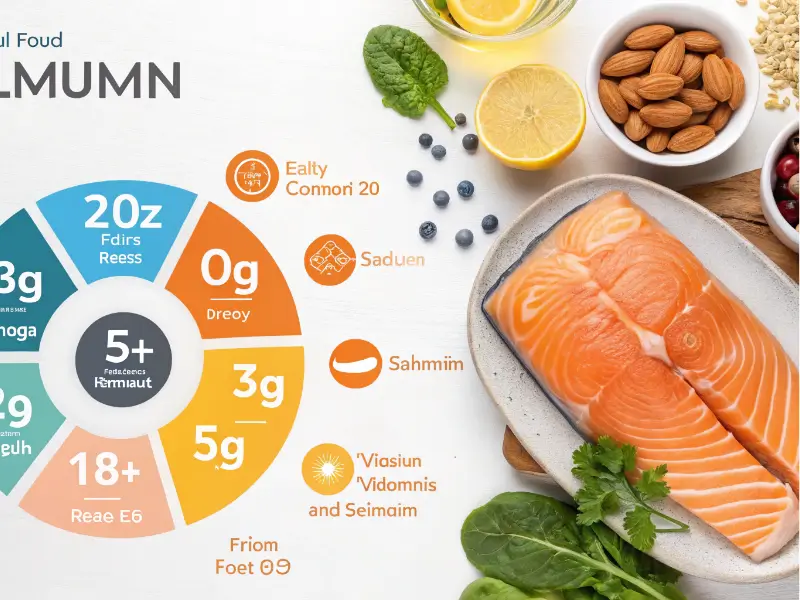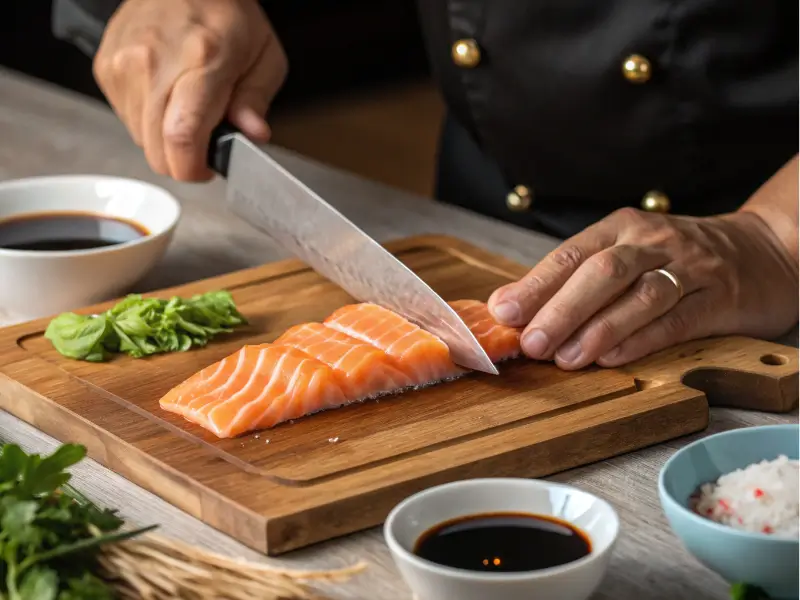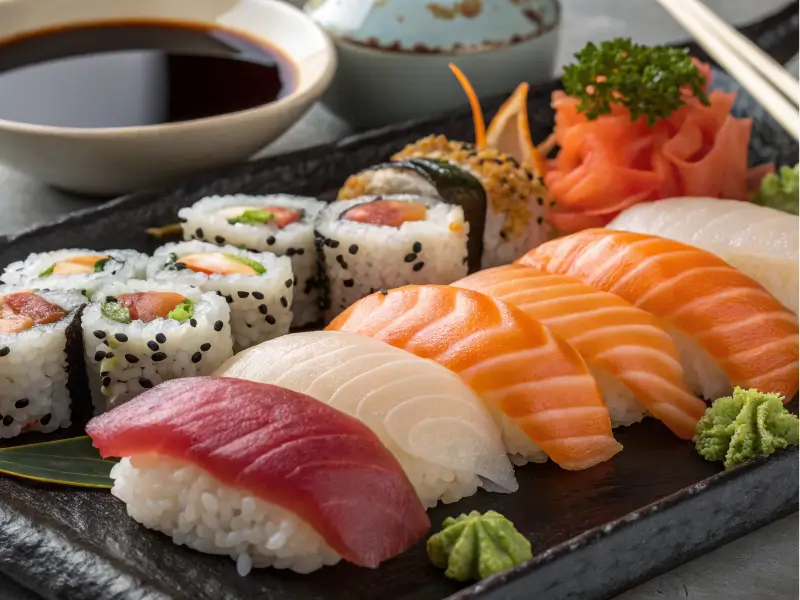When it comes to sushi, not all cuts of fish are created equal. Among the most cherished is salmon belly—a luxurious, buttery, and tender part of the fish that sushi lovers swear by. But why is this cut so prized? This article dives deep into the unique qualities of salmon belly, its health benefits, how it’s prepared for sushi, and why it’s a favorite in Japanese cuisine. By the end, you’ll understand what makes salmon belly a true star on your sushi platter.
Table of contents
Introduction Is Salmon Belly Good for Sushi
What is Salmon Belly?
Salmon belly, as the name suggests, is the fatty portion of the salmon located near its underside. This area is packed with rich, oily goodness, making it one of the most tender and flavorful parts of the fish. Thanks to its high-fat content, salmon belly has a melt-in-your-mouth texture that elevates it above other fish cuts. Its natural marbling enhances both taste and presentation, making it a sought-after ingredient in the culinary world.
Why is it Considered a Delicacy?
The luxurious mouthfeel and distinct flavor of salmon belly have earned it a reputation as a delicacy. Often regarded as the prime cut of the fish, it’s adored by sushi enthusiasts for its rich, buttery taste. In addition to sushi, it’s also popular in sashimi and other Asian-inspired dishes, showcasing its versatility. Unlike leaner fish cuts, the belly delivers an indulgent flavor that’s hard to replicate.
Overview of Its Popularity in Sushi
Is salmon belly good for sushi? Absolutely! In fact, it’s one of the top choices for sushi chefs worldwide. Its creamy texture pairs beautifully with rice, soy sauce, and other traditional condiments. Whether served as sashimi, nigiri, or in a maki roll, salmon belly adds a luxurious element to any sushi experience. It’s the perfect marriage of flavor and texture that sushi lovers crave.
Nutritional Benefits of Salmon Belly

Rich in Omega-3 Fatty Acids
One of the standout health benefits of salmon belly is its exceptional omega-3 content. Omega-3 fatty acids are crucial for heart health, brain function, and reducing inflammation. In fact, the high-fat concentration in salmon belly makes it an even better source of omega-3s compared to leaner parts of the fish. If you’re wondering, “Is salmon belly good for sushi?”, this rich nutrient profile makes it a stellar choice. Not only does it taste fantastic, but it also supports your overall well-being.
High-Quality Protein Source
Salmon belly is also a powerhouse of protein. Each bite delivers essential amino acids that help build and repair muscles, making it a great option for fitness enthusiasts and health-conscious diners alike. Whether it’s enjoyed as sashimi or nigiri, the protein-packed nature of salmon belly ensures that you’re indulging in something as nutritious as it is delicious.
Contains Essential Vitamins and Minerals
Beyond omega-3s and protein, salmon belly is loaded with key vitamins and minerals. It provides a healthy dose of vitamin D, which supports bone health, and selenium, which aids in protecting cells from oxidative damage. These nutrients further highlight why salmon belly is a top choice for sushi lovers looking to combine indulgence with nutritional benefits.
Comparison to Other Sushi Fish
When compared to other sushi-grade fish, salmon belly holds its own as a nutrient-dense option. Tuna and yellowtail may rival it in protein, but they lack the same level of omega-3 fatty acids. This makes salmon belly a more balanced choice. Plus, its natural richness adds depth to sushi dishes in a way that leaner cuts simply can’t.
Flavor Profile and Texture of Salmon Belly
What Makes Salmon Belly Unique?
Salmon belly stands out for its luscious texture and rich flavor. Its marbled fat content gives it a creamy, melt-in-your-mouth quality that few other fish can rival. This distinctive taste is one of the many reasons why chefs and diners alike consider salmon belly a luxury item. The next time you’re debating, “Is salmon belly good for sushi?”, think about how its bold flavor transforms an ordinary sushi roll into an extraordinary culinary experience.
Melt-in-Your-Mouth Quality
The high-fat content in salmon belly doesn’t just boost flavor—it also enhances the texture. Each bite feels smooth and luxurious, making it an instant hit on any sushi menu. Whether served raw or lightly seared, salmon belly’s tenderness creates a sensory experience that sushi enthusiasts adore.
How Its Fat Content Enhances Sushi Flavor
The natural oils in salmon belly do more than create a silky texture; they amplify the flavors of other sushi ingredients. Paired with soy sauce, wasabi, or citrusy yuzu, salmon belly’s fat becomes a carrier for these bold flavors. As a result, it harmonizes with the sushi rice and garnishes to create a perfectly balanced dish.
Preparing Salmon Belly for Sushi

Selecting Fresh Salmon Belly
When it comes to sushi, freshness is everything. Selecting high-quality salmon belly ensures the best flavor and safety. Look for salmon belly that has a vibrant pink-orange hue and smells faintly of the sea—not fishy. The flesh should be firm to the touch, with no discoloration or slimy texture. Wondering, “Is salmon belly good for sushi?” The answer lies in selecting fresh, sushi-grade cuts from a trusted fishmonger or supplier.
Safe Handling and Storage Practices
Proper handling of salmon belly is key to preserving its delicate texture and flavor. After purchasing, keep it chilled at all times to prevent bacterial growth. Store it in an airtight container and consume it within one to two days for optimal freshness. If you need to freeze salmon belly, wrap it tightly to avoid freezer burn, and thaw it slowly in the refrigerator before use.
Cutting Techniques for Sushi and Sashimi
Cutting salmon belly for sushi requires precision. Use a sharp knife to slice it cleanly, following the natural grain of the fish. For sashimi, cut it into thin, even slices, emphasizing the fatty marbling. For nigiri, create slightly thicker pieces to sit atop rice. These techniques ensure that the fish retains its melt-in-your-mouth quality, making it perfect for sushi.
Seasoning or Enhancing the Flavor
While the natural taste of salmon belly is exceptional, a touch of seasoning can enhance its flavor. Lightly brushing it with soy sauce or adding a hint of citrus from yuzu or lemon can elevate the experience. Alternatively, a sprinkle of sea salt highlights its buttery richness, ensuring every bite is unforgettable.
Tips and tricks on preparing seafood, check out this detailed guide to salmon belly benefits and cooking tips.
Cooking Techniques for Salmon Belly Beyond Sushi

Grilling and Broiling
Grilling salmon belly over high heat caramelizes its natural fats, creating a crispy exterior while keeping the inside moist. Broiling achieves similar results in the oven, making it an excellent option for those without a grill. Both methods unlock the rich flavors of the fish, making them popular choices for sushi enthusiasts who love cooked variations.
Pan-Searing for a Crispy Texture
Pan-searing salmon belly is another simple yet effective cooking technique. Heat a skillet, add a touch of oil, and cook the belly until the edges crisp up. The contrast between the crispy skin and the tender interior creates a delightful texture that’s perfect for sushi rolls or standalone dishes.
Incorporating Into Other Dishes Like Soups and Stews
Salmon belly isn’t just for sushi—it’s also an excellent addition to soups and stews. Its high-fat content enriches broths, lending a depth of flavor that elevates the dish. Whether added to miso soup or a creamy seafood chowder, it’s a versatile ingredient that shines in various cuisines.
Cultural Significance of Salmon Belly in Sushi

How It’s Used in Japanese Cuisine
Salmon belly holds a cherished place in Japanese cuisine, celebrated for its rich flavor and tender texture. It is often featured in traditional dishes like sashimi and nigiri, where its buttery quality can truly shine. In Japan, sushi chefs meticulously select and prepare salmon belly, treating it as a prized ingredient that reflects their culinary artistry. This reverence for salmon belly further highlights why so many people ask, “Is salmon belly good for sushi?” Its cultural importance and widespread appreciation make the answer a resounding yes.
Variations Across Different Sushi Styles
The versatility of salmon belly is another reason for its cultural significance. In sushi, it is often served as a highlight ingredient in several forms. It can be lightly seared as aburi sushi, enhancing its flavor with a smoky touch. Alternatively, it is paired with citrus or soy sauce to balance its richness in a chirashi bowl. The creamy texture and natural marbling also make it a standout choice for premium sushi rolls, adding depth to every bite. Each preparation style showcases salmon belly’s adaptability and luxurious quality.
The Art of Balancing Fatty Cuts in Sushi
Japanese sushi chefs emphasize balance in their creations, and salmon belly fits beautifully into this philosophy. Its high-fat content pairs well with vinegared sushi rice, cutting through the richness with subtle acidity. When combined with delicate toppings like yuzu zest or grated wasabi, the flavor harmony reaches new heights. This artistry explains why salmon belly is a must-have for sushi connoisseurs who crave both tradition and indulgence.
Common Questions About Salmon Belly for Sushi
Is It Safe to Eat Raw?
Safety is often a top concern when enjoying raw fish. The answer to “Is salmon belly good for sushi?” hinges on using sushi-grade fish. Sushi-grade salmon belly is carefully handled and frozen to eliminate parasites, making it safe for raw consumption. Always buy from a reputable source to ensure the highest quality and safety standards.
What Are the Best Complementary Ingredients?
Salmon belly pairs beautifully with many traditional sushi ingredients. Soy sauce, wasabi, and pickled ginger are classic options that enhance its richness. For a modern twist, chefs often use ponzu sauce, avocado, or even fresh herbs like dill to bring out its flavor. These complementary ingredients elevate the experience, proving why salmon belly is such a beloved sushi choice.
Can It Be Used for Other Types of Sushi Like Nigiri or Rolls?
Absolutely! Salmon belly is an ideal ingredient for a variety of sushi styles. In nigiri, its creamy texture and fatty richness shine atop a small ball of rice. For rolls, its marbled fat creates a luxurious mouthfeel that pairs perfectly with seaweed and other fillings. Its versatility is another reason why salmon belly remains a top pick for sushi lovers.
What Are Alternatives if Salmon Belly Is Unavailable?
If you can’t find salmon belly, there are other cuts of fish with similar qualities. Tuna belly (otoro) and yellowtail belly are excellent alternatives, offering comparable richness and texture. While these options are also prized for sushi, many enthusiasts still prefer the unique flavor of salmon belly.
FAQs
What is the Best Way to Store Leftover Salmon Belly?
Leftover salmon belly should always be stored properly to maintain its quality. First, wrap it tightly in plastic wrap or place it in an airtight container to prevent air exposure. Keep it refrigerated and consume it within one to two days. If freezing, use vacuum-sealed bags to protect its delicate texture. These storage tips not only ensure freshness but also make salmon belly safe for use in sushi, answering the question, “Is salmon belly good for sushi?” even when stored properly.
How to Identify High-Quality Salmon Belly?
High-quality salmon belly has a vibrant pink-orange color with visible marbling. The flesh should feel firm and slightly moist, not slimy or dry. A fresh ocean scent is another key indicator—avoid any fish with a strong, unpleasant odor. When purchasing, always ask your fishmonger if it’s sushi-grade to ensure it’s safe for raw consumption.
Are There Health Risks to Consuming Salmon Belly Raw?
Eating raw salmon belly is safe if it’s sushi-grade, as it undergoes freezing to eliminate parasites. However, improper handling can pose risks. To reduce concerns, always buy from trusted sources, keep it refrigerated, and follow proper hygiene practices. When prepared correctly, salmon belly is a safe and delicious addition to your sushi experience.
Can Frozen Salmon Belly Be Used for Sushi?
Yes, frozen salmon belly can be used for sushi as long as it’s sushi-grade. In fact, freezing is a standard practice to kill potential parasites in raw fish. Thaw it slowly in the refrigerator to retain its buttery texture and rich flavor, making it perfect for sushi or sashimi. This process ensures you can still enjoy the delicacy, even if fresh salmon belly isn’t available.
Conclusion and Final Thoughts
Summary of Why Salmon Belly is Excellent for Sushi
So, is salmon belly good for sushi? Without a doubt, yes! Its rich flavor, tender texture, and versatility make it a prized ingredient for sushi enthusiasts. Whether served raw as sashimi, atop rice as nigiri, or in a creative roll, salmon belly transforms ordinary sushi into a luxurious dining experience. Add to that its nutritional benefits, and it’s clear why this cut is so highly regarded.
Encouragement to Experiment with This Delicacy
If you haven’t tried salmon belly in sushi yet, now’s the perfect time. Experiment with different preparations, from lightly seared aburi to traditional sashimi, and discover your favorite way to enjoy it. Its unique qualities will not only enhance your appreciation for sushi but also showcase the artistry of Japanese cuisine. Whether you’re a sushi novice or a seasoned aficionado, salmon belly is sure to delight your taste buds and elevate your culinary adventures.

